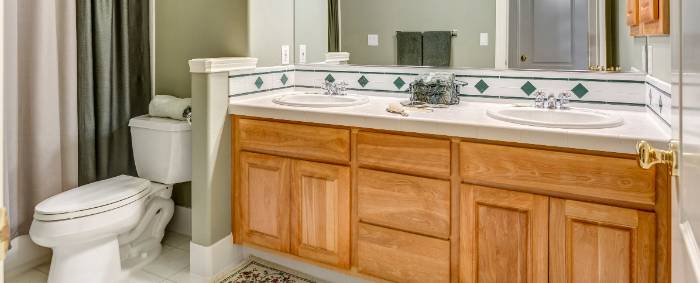Home Bathroom Could be LVAD Driveline Infection Source
New study describes the case report and gives guidelines on how to prevent infection in the home.
A home bathroom could be a source of pathogens. (Adobe Stock)

In cases of Pseudomonas aeruginosa left ventricular assist devices (LVAD) driveline infection, consider the patient's bathroom at home as a potential source of infection to reduce hospital re-admissions, repeated surgeries, and costs. Adding protective measures at home to the current standards could support infection prevention.
According to a study published in American Journal of Infection Control (AJIC), P aeruginosa is a Gram-negative pathogen that thrives in moist environments. Contaminated sinks and drains are known sources of HAI infections, and patients and their caregivers should implement and adhere to strict infection prevention and control guidelines.
“Driveline infections are feared complications in patients with left ventricular assist devices (LVAD), due to significant morbidity and mortality. The LVAD supports the cardiac function by reducing the workload of the left ventricle.” The investigators wrote in the study. “This case illustrates the need for infection prevention measures at home.”
The case noted in the study involved a patient aged 54 suffering from end stage heart failure, based on dilating cardiomyopathy.The patient was given an LVAD (HeartMate III Abbott) as bridge to heart transplant. Conforming to the investigators’ clinical protocol, the patient refrained from showering during the first 3 months following LVAD surgery. At routine outpatient clinic evaluation, the surgery wound was healing as anticipated, with no signs of infection present. Thus, the patient was allowed to shower at home 3 months after LVAD placement. The patient’s instructions said to replace the dressing after showering. Although the patient had 6 weeks of antibiotics, a positron emission tomography and computed tomography (PET-CT) scan showed continuing inflammation and the driveline was surgically relocated. Ceftazidime was continued for 14 days post-surgery.
Culture swabs were taken from the patient's bathroom at home to identify the source of the infection. The investigators found P aeruginosa on the shower drain, a wall-mounted shower head, and the non-slip shower mat. Molecular typing by Multiple Locus Variable-Numbers Tandem Repeat Analysis (MLVA); a method used to determine the genetic relatedness among bacterial strains, exposed that all environmental isolates were like the P aeruginosa from the exit site. The investigators wrote that the driveline exit site MLVA type was 1-5-11-2-6-12-8-4. These results were validated by whole genome sequencing. Environmental isolates differed only 1-9 loci (out of 5967) from the clinical isolate (Illumina technology in BioNumerics v7.6; Applied Maths, St-Martens-Latem, Belgium), which is well below the proposed cut-off value of 13 alleles difference. All isolates belonged to Sequence Type (ST)348.
“Our patient was most likely infected at home by upward transmission (eg splashing, via towel use) from the mat and shower drain, as both tested positive for P aeruginosa, the investigators explained. “The wall-mounted shower jet also tested positive but was not used. Direct transmission from water by showering seems unlikely as the main showerhead, and the water tested negative. Airborne transmission from the drain has been reported, with Pseudomonas positive air samples after showering. However, this was not investigated in our case.”
Guidelines in Bathroom From Study
Consistent drying of the shower and sink after use is highly recommended because waterborne pathogens do not as easily grow in a dry environment. Non-slip shower mats can harbor bacteria because bacteria can easily attach to and grow on the material. Also, all cleaning materials should be washed at 60⁰ Celsius immediately after use.
“This list could increase awareness about community infection risks and might also be protective of other waterborne pathogens,” the investigators said. “As we assume the patients’ entire shower system contains a biofilm with P aeruginosa, we additionally advised faucet filters to sterilize water.”
- Prevent splashing of water, preferably by installing a covering drain top.
- Dry sink and surroundings, outwards to inwards.Avoid touching drain with drying towel.
- Dry rubber plug, if applicable.Clean plug in a washing machine or dishwasher weekly, preferably at 60⁰ Celsius or higher.
- Dry shower cabin after use.
- Consider shower floor and sink as potentially contaminated with pathogens. Avoid contact with towels and other cleaning attributes.
- Using a non-slip shower mat is highly discouraged.
Show, Tell, Teach: Elevating EVS Training Through Cognitive Science and Performance Coaching
April 25th 2025Training EVS workers for hygiene excellence demands more than manuals—it requires active engagement, motor skills coaching, and teach-back techniques to reduce HAIs and improve patient outcomes.
The Rise of Disposable Products in Health Care Cleaning and Linens
April 25th 2025Health care-associated infections are driving a shift toward disposable microfiber cloths, mop pads, and curtains—offering infection prevention, regulatory compliance, and operational efficiency in one-time-use solutions.
Phage Therapy’s Future: Tackling Antimicrobial Resistance With Precision Viruses
April 24th 2025Bacteriophage therapy presents a promising alternative to antibiotics, especially as antimicrobial resistance continues to increase. Dr. Ran Nir-Paz discusses its potential, challenges, and future applications in this technology.